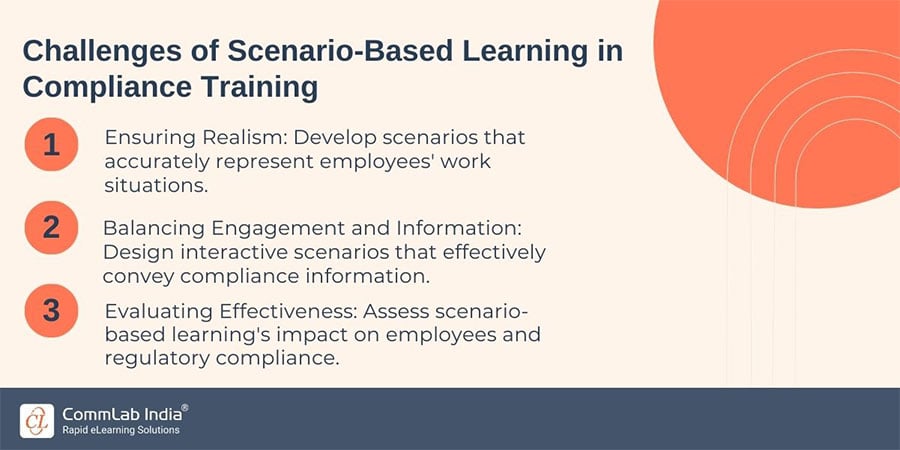Crack the Code: Scenario-Based Learning for Top-notch Compliance Training

Organizations face compliance risks every day. From data privacy to anti-corruption, the potential for non-compliance is always present. And, the consequences of non-compliance can be severe. That’s why compliance training is so important. Along with robust compliance training programs, organizations are also under increasing pressure to develop compliance training that is both effective and engaging. And scenario-based learning, which is a powerful instructional design strategy that can help organizations meet these challenges.
Scenario-based learning involves presenting learners with realistic situations and challenges that they may encounter in the workplace. Learners must then apply their knowledge and skills to resolve the situation. This type of employee training is often used in compliance training, as it can help learners to understand and remember complex information.
When used correctly, scenario-based learning can be an extremely effective way to train employees on compliance issues.
Scenario-Based Learning is a Promising Way to Deliver Impactful Compliance Training
Some of the benefits of the ID strategy include:
- It’s engaging
- It’s realistic
- It promotes critical thinking
- It builds confidence
- 5. It’s cost-effective
Benefits of Scenario-Based Learning for Compliance Training
Here are some of the benefits of scenario-based learning for compliance training:
- It’s engaging: Scenario-based learning is more engaging than traditional eLearning because it’s interactive and immersive. Learners are actively involved in the learning process, which makes it more memorable and meaningful.
- It’s realistic: Scenarios are based on real-world situations, so learners can see how their decisions might play out in the real world. This helps them to understand the implications of their choices and makes the training more relevant to them.
- It promotes critical thinking: In order to choose the correct course of action in a scenario, learners need to think critically about the situation and weigh up all their options. This type of thinking is essential for making proper decisions even under pressure, which is what’s required in many compliance situations.
- It builds confidence: Scenarios allow learners to practice making decisions in a safe environment. This helps to build their confidence and gives them the courage to make the right decisions when they’re faced with a difficult compliance situation in real life.
- It’s cost-effective: Scenario-based learning is an affordable way to train employees on compliance issues. It eliminates the need for costly classroom training, travel expenses, and other associated costs.
Considering these benefits, it can be said that scenario-based learning is one of the best suited approaches to engage your employees in digital learning training sessions.
Challenges of Scenario-Based Learning in Compliance Training
Organizations face certain challenges when developing scenario-based learning for compliance training. The following are some challenges:

→ Download Now: Instructional Design Strategies to Design Engaging eLearning Courses
Strategies for Developing Effective Scenario-Based Learning Experiences
When it comes to compliance training, one size does not fit all. The best way to ensure that your employees are getting the most out of their training is to tailor the learning experience to their specific needs. Here are some tips for developing effective scenario-based learning experiences:

- Define the objectives of the training. What do you want your employees to learn? What skills do they need to develop? Be as specific as possible when defining the training objectives.
- Develop realistic scenarios. The scenarios should be based on real-life situations that your employees might encounter in their work. They should be challenging enough to engage learners, but not so difficult that they become frustrated and give up.
- Include a mix of activities. Scenario-based learning experiences should include a mix of activities, such as role-playing, simulations, and case studies. This will help keep learners engaged and ensure that they are able to apply what they have learned to real-world situations.
- Give learners enough time to complete each scenario. If they feel rushed, they may not be able to fully engage with the material and may not learn as much as they could otherwise.
- Provide feedback and guidance. Throughout the learning experience, provide feedback and guidance so that learners can understand how they are doing and where they need to improve. This will help them transfer what they have learned to their work environment.
How to Measure the Success of Your Scenario Based eLearning Courses?
When it comes to measuring the success of your scenario-based eLearning courses, there are a few key indicators that you should keep in mind. First and foremost, you’ll want to look at completion rates. This will give you a good idea of how well learners are engaging with the material.
Additionally, you should also look at post-course surveys and focus groups (if you’re able to conduct them). These can provide valuable insights into how learners felt about the course, what they found most helpful, and what areas they would like to see improved.
It’s also important to track changes in behaviour after completing a scenario-based eLearning course. Did learners start using more safety precautions? Were there fewer accidents or incidents reported? By looking at these types of outcomes, you can get a better sense of whether or not your courses are truly making an impact.
Wrapping Up
When it comes to compliance training, scenario-based learning can be an extremely effective tool for eLearning developers. By providing learners with realistic situations that they may encounter in their work, scenario-based learning can help them to better understand the consequences of their actions and make more informed decisions.
While scenario-based learning remains to be one of the best ID strategies that also helps improve learner engagement and motivation, there are several other ID strategies that can make the training more interesting and enjoyable.
Interested in knowing more about these ID strategies? This eBook can guide you…





